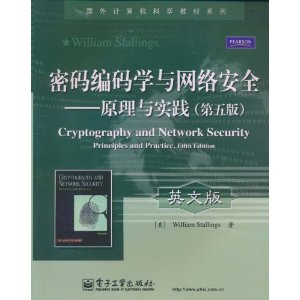內容簡介
 密碼編碼學與網路安全:原理與實踐
密碼編碼學與網路安全:原理與實踐《密碼編碼學與網路安全:原理與實踐(第5版)(英文版)》可作為高校計算機專業、網路安全專業、通信安全專業等相關專業的本科生和研究生的教材,也可供相關技術人員參考使用。
作者簡介
作者:(美國)斯托林斯(William Stallings)
圖書目錄
Notation xiii
Preface xv
About the Author xxiii
Chapter 0 Reader's Guide 1
0.1 Outline of This Book 2
0.2 A Roadmap for Readers and Instructors 2
0.3 Internet andWeb Resources 4
0.4 Standards 5
Chapter 1 Overview 7
1.1computer securityConcepts 9
1.2 The OSI Security Architecture 14
1.3 Security Attacks 15
1.4 Security Services 19
1.5 Security Mechanisms 23
1.6 A Model for Network Security 25
1.7 Recommended Reading andWeb Sites 27
1.8 Key Terms, Review Questions, and Problems 29
PART ONE SYMMETRIC CIPHERS 31
Chapter 2 Classical Encryption Techniques 31
2.1 Symmetric Cipher Model 33
2.2 Substitution Techniques 38
2.3 Transposition Techniques 53
2.4 Rotor Machines 55
2.5Steganography57
2.6 Recommended Reading andWeb Sites 59
2.7 Key Terms, Review Questions, and Problems 60
Chapter 3 Block Ciphers and the Data Encryption Standard 66
3.1 Block Cipher Principles 68
3.2 The Data Encryption Standard (DES) 77
3.3 A DES Example 85
3.4 The Strength of DES 88
3.5 Differential and Linear Cryptanalysis 89
3.6 Block Cipher Design Principles 92
3.7 Recommended Reading and Web Site 96
3.8 Key Terms, Review Questions, and Problems 97
Chapter 4 Basic Concepts in Number Theory and Finite Fields 101
4.1 Divisibility and the Division Algorithm 103
4.2 The Euclidean Algorithm 105
4.3 Modular Arithmetic 108
4.4 Groups, Rings, and Fields 116
4.5 Finite Fields of the FormGF(p)120
4.6 Polynomial Arithmetic 122
4.7 Finite Fields of the Form GF(2n) 129
4.8 Recommended Reading andWeb Sites 141
4.9 Key Terms, Review Questions, and Problems 141
Appendix 4AThe Meaning ofmod 144
Chapter 5 Advanced Encryption Standard 47
5.1 The Origins AES 148
5.2 AES Structure 150
5.3 AES Round Functions 155
5.4 AES Key Expansion 166
5.5 An AES Example 169
5.6 AES Implementation 174
5.7 Recommended Reading and Web Sites 178
5.8 Key Terms, Review Questions, and Problems 179
Appendix 5A Polynomials with Coefticients in GF(28) 180
Appendix 5B Simplified AES 183
Chapter 6 Block Cipher Operation 192
6.1 Multiple Encryption and Triple DES 193
6.2 Electronic Codebook Mode 198
6.3 Cipher Block Chaining Mode 201
6.4 Cipher Feedback Mode 203
6.5 Output Feedback Mode 205
6.6Counter Mode206
6.7 XTS Mode for Block-Oriented Storage Devices 210
6.8 tLecommendedWeb Site 214
6.9 Key Terms, Review Questions, and Problems 214
Chapter 7 Pseudorandom Number Generation and Stream Ciphers 218
7.1 Principles of Pseudorandom Number Generation 219
7.2 Pseudorandom Number Generators 226
7.3 Pseudorandom Number Generation Using a Block Cipher 229
7.4 Stream Ciphers 232
7.5 tLC4 234
7.6 True Random Numbers 237
7.7 Recommended Reading 238
7.8 Key Terms, Review Questions, and Problems 239
PART TWO ASYMMETRIC CIPI-I~.I~S 243
Chapter 8 More Number Theory 243
8.1 Prime Numbers 245
8.2 Fermat's and Euler's Theorems 248
8.3 Testing for Primality 251
8.4 The Chinese tLemainderTheorem 254
8.5 Discrete Logarithms 257
8.6 Recommended Reading andWeb Sites 262
8.7 Key Terms, Review Questions, and Problems 263
Chapter 9 Public-Key Cryptography and RSA 266
9.1 Principles of Public-Key Cryptosystems 269
9.2 The RSA Algorithm 277
9.3 Recommended Reading andWeb Sites 291
9.4 Key Terms, Review Questions, and Problems 291
Appendix 9A Proof of the RSA Algorithm 296
Appendix 9B The Complexity of Algorithms 297
Chapter 10 Other Public-Key Cryptosystems 300
10.1 Diffie-Hellman Key Exchange 301
10.2 E1Gamal Cryptosystem 305
10.3 Elliptic Curve Arithmetic 308
10.4 Elliptic Curve Cryptography 317
10.5 Pseudorandom Number Generation Based on an Asymmetric Cipher 321
10.6 Recommended Reading and Web Sites 323
10.7 Key Terms, Review Questions, and Problems 324
PART THREE CRYPTOGRAPHIC DATA INTEGRITY ALGORITHMS 327
Chapter 11 Cryptographic Hash Functions 327
11.1 Applications of Cryptographic Hash Functions 329
11.2 Two Simple Hash Functions 333
11.3 Requirements and Security 335
11.4 Hash Functions Based on Cipher Block Chaining 341
11.5 Secure Hash Algorithm (SHA) 342
11.6 SHA-3 352
11.7 Recommended Reading andWeb Sites 353
11.8 Key Terms, Review Questions, and Problems 353
Appendix 11A Mathematical Basis of Birthday Attack 356
Chapter 12 MessageauthenticationCodes 362
12.1 Message Authentication Requirements 364
12.2 Message Authentication Functions 365
12.3 Message Authentication Codes 372
12.4 Security of MACs 374
12.5 MACs Based on Hash Functions:HMAC375
12.6 MACs Based on Block Ciphers: DAA and CMAC 380
12.7 Authenticated Encryption: CCM and GCM 383
12.8 Pseudorandom Number Generation Using Hash Functions and MACs 389
12.9 Recommended Reading 392
12.10 KeyTerms, Review Questions, and Problems 393
Chapter 13 Digital Signatures 395
13.1 Digital Signatures 396
13.2 E1Gamal Digital Signature Scheme 400
13.3 Schnorr Digital Signature Scheme 402
13.4 Digital Signature Standard (DSS) 403
13.5 Recommended Reading andWeb Sites 406
13.6 Key Terms, Review Questions, and Problems 407
PART FOUR MUTUAL TRUST 410
Chapter 14 Key Management and Distribution 410
14.1 Syrmnetric Key Distribution Using Symmetric Encryption 412
14.2 Symmetric Key Distribution Using Asymmetric Encryption 421
14.3 Distribution of Public Keys 423
14.4 X.509 Certificates 428
14.5 Public Key Infrastructure 436
14.6 Recommended Reading and Web Sites 438
14.7 Key Terms, Review Questions, and Problems 439
Chapter 15 User Authentication Protocols 444
15.1 Remote User Authentication Principles 445
15.2 Remote User Authentication Using Symmetric Encryption 448
15.3 Kerberos 452
15.4 Remote User Authentication Using Asymmetric Encryption 470
15.5 Federated Identity Management 472
15.6 Recommended Reading andWeb Sites 478
15.7 Key Terms, Review Questions, and Problems 479
Appendix 15A Kerberos Encryption Techniques 481
PART FIVE NETWORK AND INTERNET SECURITY 485
Chapter 16 Transport-Level Security 485
16.1 Web Security Issues 486
16.2 Secure Sockets Layer (SSL) 489
16.3 Transport Layer Security (TLS) 502
16.4 HTTPS 506
16.5 Secure Shell (SSH) 508
16.6 Recommended Reading andWeb Sites 519
16.7 Key Terms, Review Questions, and Problems 519
Chapter 17 Wireless Network Security 521
17.1 IEEE 802.11 Wireless LAN Overview 523
17.2 IEEE 802.11i Wireless LAN Security 529
17.3 Wireless Application Protocol Overview 543
17.4 Wireless Transport Layer Security 550
17.5 WAP End-to-End Security 560
17.6 Recommended Reading andWeb Sites 563
17.7 Key Terms, Review Questions, and Problems 563
Chapter 18 Electronic Mail Security 567
18.1 Pretty Good Privacy (PGP) 568
18.2 S/MIME 587
……
Appendix Q International Reference Alphabet
Glossary
